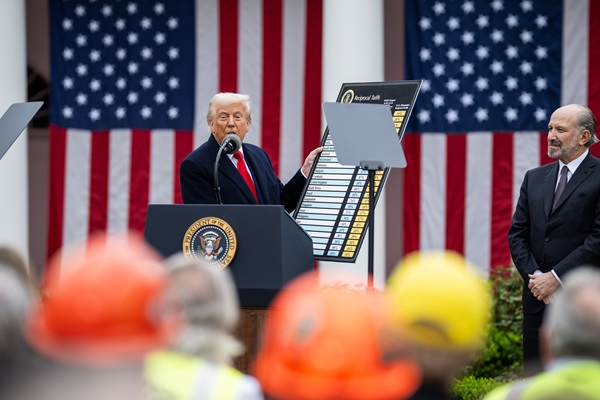.png)

Batabyal is a Distinguished Professor of economics and the Head of the Sustainability Department at the Rochester Institute of Technology, NY. His research interests span environmental, trade, and development economics.
May 16, 2025 at 7:35 AM IST
On April 2, 2025, a date President Trump proclaimed “Liberation Day,” the administration announced the most sweeping hike in tariffs since the Smoot-Hawley Tariff Act, the 1930 law best remembered today for triggering a global trade war and deepening the Great Depression.
These most recent tariffs have targeted almost all US trade partners, thereby marking a dramatic strengthening of his “America First” trade policy. These tariffs, which also dramatically escalate his earlier trade wars from 2018-19, are intended to protect domestic industries, reduce trade deficits, and pressure other nations into more favorable trade agreements. However, economists and policymakers are deeply divided over whether these measures will strengthen the US economy or impose severe costs on businesses and consumers.
This essay examines the likely consequences of Trump’s 2025 tariffs for the US economy, focusing primarily on their impact on manufacturing, employment, and consumers, with some discussion of other macroeconomic impacts. It draws on lessons from the 2018-19 trade wars and contemporary economic data and analysis and contends that while some industries may benefit in the short term, the broader effects of the tariffs could include higher inflation, supply chain disruptions, retaliatory trade measures, and slower gross domestic product growth.
President Trump’s April 2025 tariffs expand significantly on his earlier trade policies, which relied on Section 232 (national security tariffs) and Section 301 (intellectual property and unfair trade practices) to justify import restrictions. His current measures include broad-based tariffs on imports from China (145% on most goods at one point), expanded steel and aluminum tariffs (now 25% on both), new tariffs on automobiles, electronics, and consumer goods from the EU, Mexico, and Japan, and, finally, retaliatory threats against countries that impose counter-tariffs.
The stated goal of these punitive trade policies is to address what the Trump administration believes are unfair trade practices, to force the reshoring of manufacturing jobs, and to reduce America’s reliance on foreign supply chains. This notwithstanding, the policies themselves risk triggering a major global trade war.
Manufacturing Hit
It is helpful to divide the following discussion about the US manufacturing sector into what economists call short-run versus long-run impacts. In the short-run, protected industries such as steel, aluminum, and heavy manufacturing may well see an expansion in domestic production as foreign competition becomes more expensive. Specifically, some companies may reshore some of their operations to avoid President Trump’s tariffs, particularly in semiconductors and in electric vehicles. In this regard, existing government subsidies such as the ones created by the CHIPS Act may amplify these effects, thereby encouraging domestic investment.
That said, from a long-run perspective, things look quite different. Specifically, President Trump’s tariffs are likely to create long-run risks in terms of supply chain disruptions and higher costs. This is because many manufacturers rely on imported components and tariffs are sure to raise production costs and reduce competitiveness. Specifically, automakers and electronics firms may face profit margin squeezes, leading to higher prices or reduced output. Even foreign direct investment could decline if multinationals believe that the US market is now less stable and therefore less desirable to invest in.
It is worth asking whether President Trump’s tariffs will succeed in reshoring manufacturing back to America. Past experience from 2018-19 shows that tariffs alone do not guarantee long-term reshoring—many firms shifted to Vietnam or Mexico rather than return to the US. Finally, without additional industrial policy support, the US may not be successful in rebuilding the high-value manufacturing capacity that President Trump says he wishes to see.
Employment Loss
It is likely that we will see some job gains in sectors of the US economy that are protected because of President Trump’s tariffs. In particular, steel, aluminum, and some machinery industries may well see modest employment increases. One wonders, though, about the cost to consumers from such job gains. Looking to President Trump’s first term, one study argued that in 2018, his tariffs on washing machines did create 1800 US jobs but at a very high cost of $820,000 per job for consumers!
Because of complementarities between companies in manufacturing, some policies instituted by President Biden such as the Inflation Reduction Act and the CHIPS Act may further boost these tariff driven employment gains in clean energy and semiconductors.
Although small job gains are likely in some sectors of the US economy, it is worth emphasising four points. First, job losses are likely to outstrip gains and such losses are particularly likely in export dependent industries. Second, President Trump’s tariffs are very likely to raise the costs of inputs and thereby lead American automotive and aerospace sectors to cut jobs. Third, if China were to retaliate by targeting US agriculture and the EU were to retaliate by going after American whiskey then these actions could have hugely deleterious effects on US exporters and therefore on jobs in these affected sectors. In a worst-case scenario, it may be necessary to provide a massive farm bailout like the $28 billion in tariff aid given to farmers in 2020. Finally, the net employment effect of President Trump’s tariffs is already predicted to be negative.
Consumers Hurt
Standard international trade theory shows that President Trump’s tariffs will unambiguously hurt American consumers by raising prices on a whole host of goods. In this regard, the Yale Budget Lab estimates that the new tariffs will increase consumer prices by 2.9% in the short-run. This is the equivalent of an average per household consumer loss of $4,700 in 2024 dollars. Simply put, a variety of commonly used consumer goods such as electronics, clothing, and cars will become more expensive because of President Trump’s tariffs.
It is worth stressing a particularly unsavory aspect of the tariffs that President Trump has championed. This aspect stems from the fact that tariffs act like regressive taxes. This means they are more than likely to hurt lower income households with a minimal impact on the top 1% of earners in 2026. This is so because lower income families tend to spend more of their budget on tariff-affected goods, thereby worsening economic inequality in the nation.
Finally, it should not go unsaid that consumer sentiment in the US has declined sharply, with consumer confidence sinking 7.9 points in April 2025 to a reading of 86 (1985=100), the Conference Board said in its latest survey. That is the lowest level since May 2020 and a larger decline than economists had projected. Consistent with this statistic, the fraction of Americans anticipating a recession in the year ahead climbed to a two-year high, the survey showed. Trump’s tariffs were “on top of consumers’ minds,” according to their write-in responses.
Macroeconomic Impacts
Given the considerable uncertainty surrounding many aspects of President Trump’s tariffs, the Federal Reserve may keep interest rates higher for a longer period of time, thereby slowing economic growth. On a related note, if the announced tariffs coincide with tight monetary policy then the US could face the risk of 1970s-style stagflation.
Second, the US trade deficit, which President Trump has repeatedly said he would like to see shrink, may not shrink. Recent theoretical research shows that there are some circumstances in which permanent tariffs can bring down the trade deficit. Even so, the existing empirical evidence demonstrates that instead of reducing the deficit, past tariffs by President Trump increased the deficit, contrary to what he would like to see happen. In addition, instead of reducing the deficit, past tariffs levied by President Trump in his first term diverted trade to Vietnam and Mexico, making these nations the big winners.
Third, President Trump’s tariffs could cause GDP growth in the US to decelerate. In this regard, it is worth noting that the Budget Lab at Yale University estimated that the tariffs would reduce real GDP growth in the US by 0.6 percentage points in 2025. Further, in the long-run, the US economy would be persistently 0.3-0.4% smaller which is the equivalent of $80-110 billion annually in 2024 dollars.
Finally, President Trump’s tariffs on major trading partners have reignited fears of a global trade war. Targeting key imports from Canada, China, the European Union, and Mexico, these measures risk retaliatory tariffs that could spiral into broader economic conflict. Disrupted supply chains, rising consumer prices, and reduced investor confidence may follow, threatening global economic stability. The World Trade Organization has voiced concern, urging restraint and diplomacy. Historical precedents suggest prolonged trade disputes can significantly slow global growth. If allies and rivals alike respond aggressively, the tariffs could undermine multilateral cooperation, escalate tensions, and damage the global trading system for years to come.
President Trump’s April 2025 tariffs have had immediate and significant effects on the American economy. While intended to reshore manufacturing and protect domestic industries, the tariffs have led to higher production costs, job losses in certain sectors, higher consumer prices, and perhaps most importantly, great economic uncertainty. The long-term impacts will depend on various factors, including potential retaliatory measures by trade partners and adjustments within domestic industries. President Trump and other trade policymakers need to carefully consider these dynamics to mitigate the adverse effects of tariffs and promote sustainable economic growth.




